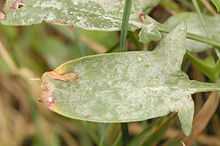Erysiphe betae
| Erysiphe betae | |
|---|---|
 | |
| Scientific classification | |
| Kingdom: | Fungi |
| Phylum: | Ascomycota |
| Class: | Leotiomycetess |
| Subclass: | Leotiomycetidae |
| Order: | Erysiphales |
| Family: | Erysiphaceae |
| Genus: | Erysiphe |
| Species: | E. betae |
| Binomial name | |
| Erysiphe betae (Vaňha) Weltzien, (1963) | |
| Synonyms | |
|
Erysiphe communis f. betae | |
Erysiphe betae is a plant pathogen. It is a form of powdery mildew that affects sugar beet. The fungus occurs worldwide in all regions where sugar beet is grown and it also infects other edible crops, e.g. beetroot.
Identification
This pathogen is a strict obligated parasite, and therefore can only be identified when in planta.
Description
This fungus has a white powdery appearance. It appears on leaves in the summer time. Infection normally begins on older leaves, typically close to the junction between the lamina and petiole, and it develops on both ab- and adaxial surfaces.
Pathogenicity
This pathogen decreases yields in crops by the reduction of chlorophyll in the leaves of plants. This will affect (as was mentioned) the yield and the quality of the seed crops. It also causes leaf and shoot deformities. In the case of Erysiphe betae, entry into the cell is both mechanical penetration and enzymatic degradation of the cuticle and the cell wall.
Plant defenses
The way that plants deal with these enzymes is they have an array of specialized inhibitors that counter act the effects of that specific pathogen. Some of these degrading enzymes include pectin lyases and polygalacturonases. In the case of when the pathogen gets entry through mechanical means the plant in itself doesn’t have much it can do against this kind of attack.
Methods of control
In the case of control against Erysiphe betae, not much is known about how to totally eradicate this disease once it has taken hold of your crop. It must therefore be assumed that the best method of control is prevention. Reducing the chances of this pathogen getting into your crop seems to be the best way of stopping this disease.
External links
| Wikimedia Commons has media related to Erysiphe betae. |
References
- Robin Philippe (n.a.). Powdery mildew. Retrieved November 4, 2007 from , Web site: http://www.inra.fr/hyp3/pathogene/6erybet.htm#haut
- Dr. Alan J. Silverside (2002, September). Erysiphe cichoracearum DC. var. cichoracearum. Retrieved November 4, 2007 from , Website: http://www-biol.paisley.ac.uk/bioref/Fungi_ascomycetes/Erysiphe_cichoracearum.html